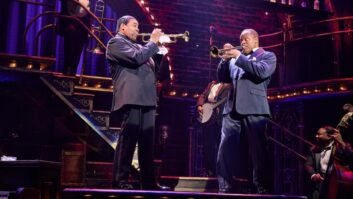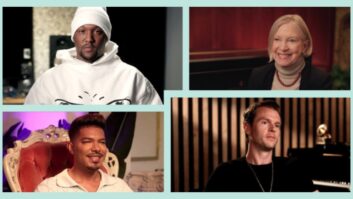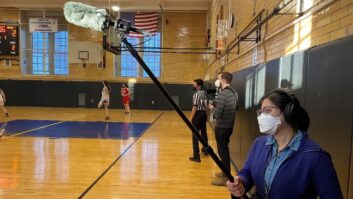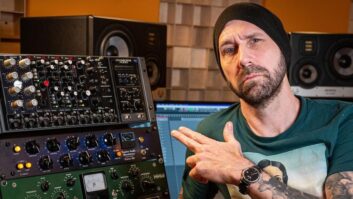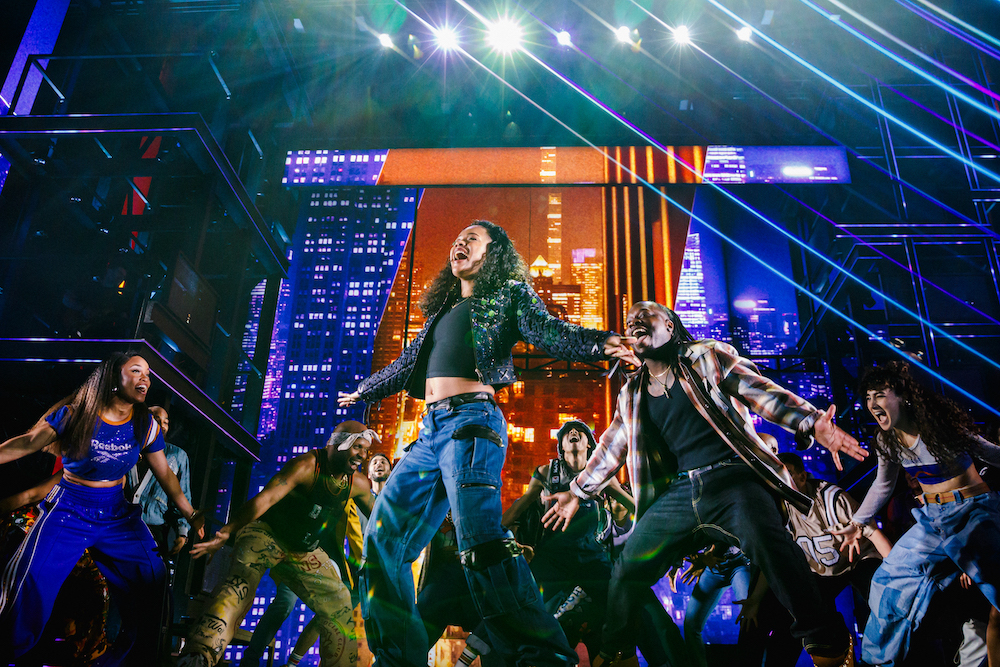
New York, NY (June 4, 2024)—Hell’s Kitchen has all the necessary ingredients for a Broadway hit, and on stage, they mix together for a tasty, crowd-pleasing show. The brainchild of 16-time Grammy Award winner Alicia Keys, the musical takes inspiration from the singer’s years growing up in 1990s New York City, following young high-schooler Ali as she navigates first love, an overprotective mom, a demanding mentor and discovering her true calling as a musician. All throughout, Keys’ familiar hits and a passel of new tunes move the story forward, keeping the audience’s toes tapping along the way. Ensuring that the crowd hears every note is sound designer Gareth Owen, whose work on the show has now been nominated for Best Sound Design of a Musical—one of 13 Tony Award nominations the production earned in April, less than a week after it opened on the Great White Way.
While Hell’s Kitchen nabbed its nominations practically overnight, its journey to the Shubert Theatre was a considerably longer journey. Keys first began developing the show in 2011, and it finally hit the stage with an Off-Broadway run last fall at The Public Theater. Owen was already onboard with the musical by then, but the audio system he created at the time was a far cry from the one in-use now on Broadway. “We had to use whatever equipment we could get our hands on, and that’s standard for tryouts—you use whatever is available, resources-wise,” he said.
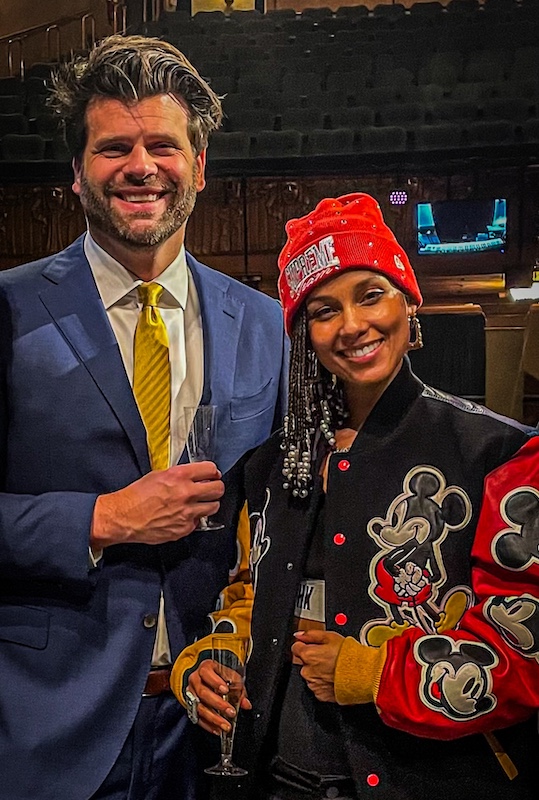
As a result, when the show moved to Broadway, Owen and his team largely started over from scratch, working with longtime theatrical audio provider Sound Associates. “We changed consoles, P.A. systems, amplifiers, processing,” he recalled. “It’s easier to list the things we didn’t change moving to Broadway.”
Taking the show uptown allowed Owen to switch the house console to an Avid S6L, a desk likewise used on all his other current Broadway productions—MJ (for which he won a Tony), & Juliet, Tommy and Back to the Future. Swapping out desks wasn’t entirely painless; copying and reinterpreting each setting from another brand’s console to the S6L took about a week but proved to be time well-spent as the programming and settings translated tightly.
Based as it is around modern-day pop, the show’s mix uses plenty of plug-ins, he said, noting, “Almost everything that exists in an AAX DSP format, we’ve got running inside the console, but then externally, we have a plug-in host system that’s mostly running reverbs. We’re running emulations of the t.c. electronic VSS3 and VSS4 HD reverbs, LiquidSonics emulations of the Bricasti M7—the Seventh Heaven plugins— and some plate reverbs; and a whole lot of funky effects from SoundToys.”
Much of the software used at the FOH position, however, is custom-written. Owen’s own software house, Show Control Ltd., creates digital tools solely for use on his productions, so creations like rPatch, a 64×64 Dante-enabled digital patch bay for radio mic systems, and rLab, a group of QLab plug-ins, are put to good use nightly. Also on hand is EnSnap; built to control d&b audiotechnik’s Soundscape immersive audio system, Owen’s company ultimately licensed the software directly to d&b.
The Soundscape technology is well applied in Hell’s Kitchen, too. As one of the first Broadway shows to use a d&b XSL P.A. (Owen’s & Juliet sound design was reportedly the first), the main Soundscape arrays are d&b XSL hangs supported by a half-dozen flown SL-Subs. A bevy of E6, E8, Y7P and Y10P boxes handle delays and surround chores, while E6 front fills sit in a line across the front of the stage, just above more SL-Subs under the front edge of the deck.
“A good thing about this show is that the scenic designer, Robert Brill, very much doesn’t want to hide anything,” said Owen. “The set design is very industrial, as is the lighting design, so as a result, everything is very exposed and intentionally visible; it’s alright to see most of the speakers as opposed to what a lot of scenic designers want, which is to hide as much as possible.”
While that industrial staging adds to the show’s look, all eyes are focused throughout on the big musical numbers and quiet, dramatic moments. The ensemble is captured via DPA 4066 head-worn microphones leading to Shure ADX1M micro wireless bodypack transmitters, and some key cast members additionally have backup Sennheiser MKE 1 mics strapped to their booms as well, wearing two bodypacks so that the audio team can switch to the backup in an emergency.
With so many wireless systems employed on the production, the audio team uses multiple Wavetool systems to keep tabs on them all, not only as the main monitoring system backstage but also with a remote monitoring station for the front-of-house mix position. Additionally, portable Wavetool tablets are used by audio crew members backstage to check mics. “They could be up in a dressing room, checking microphones while standing next to a performer, and say ‘That’s good’ or ‘I’m gonna fix that,’” Owen explained. “One person can do the whole check, and because the client and the remote system in Wavetool are independent of each other, two people can do different things without interfering with each other. That’s a real workflow, a real timesaver.
“There’s another feature in Wavetool that I’m personally very proud of—because it was my idea: You can rewind the audio from anyone’s radio mic! If the front-of-house engineer says, ‘I think we just had a dropout on Ali,’ backstage, they can rewind back 15 seconds and listen to what happened. This was an idea that I’ve been bleating on about for ages, but I didn’t really think it would happen. It was a super-useful feature that I wanted and then suddenly it magically appeared!”
The orchestra is located beneath the stage, bolstered by a handful of musicians visible in a pair of towers adorning the set. Players hear themselves via Sennheiser HD 25 and Sony MDR- 7509HD headphones plugged into Allen & Heath ME-1 40-source personal mixers. “Not only is the build quality on the mixer absolutely fabulous, but the audio quality and flexibility are hands down better than anything else on the market,” said Owen.

There are also multiple mobile musicians who roam the stage as well, with their playing transmitted via Shure PSM 1000 wireless systems. Not all the stage instruments are real, however; multiple pianos “played” by the actors each contain a speaker, amplifier and Shure PSM 1000 receiver. “The person on stage pretends that they’re playing the piano,” said Owen, “and we beam the sound of somebody who can actually play into it so that the sound comes from the piano; we call them ‘reverse radios.’”
With all that technology brought to bear on a modern-day musical full of hip-hop beats, jazz, old-school R&B, rap and more, Hell’s Kitchen doesn’t sound like a typical Broadway show—and that’s just the way Owen likes it: “The traditional music theater sound for a long time was about pretending that sound didn’t exist. It was all about microphones hidden in the hat, the sound of the orchestra coming out of the orchestra pit and voices coming from the people onstage. A ‘good’ sound design was considered to be one you wouldn’t know was there.
“People go to the movies, hear an orchestra swell around them and they feel it. They put in their AirPods and hear amazing sound, get in their car and hear 29 speakers, or spend $600 at Target on an amazing surround system for their front room—and yet we still go to a theater and pretend like sound doesn’t exist! I realized, ‘No, the world’s moved on. I’m going to stop apologizing for sound.’ I made a conscious decision to take it in a completely different direction, which is a cinematic sound design—so I don’t really do shows that sound like traditional Broadway shows; that’s not really my thing.” Perhaps so, but depending on how his latest Tony nomination—his fifth—plays out, Owen may be founding a new tradition all his own.
